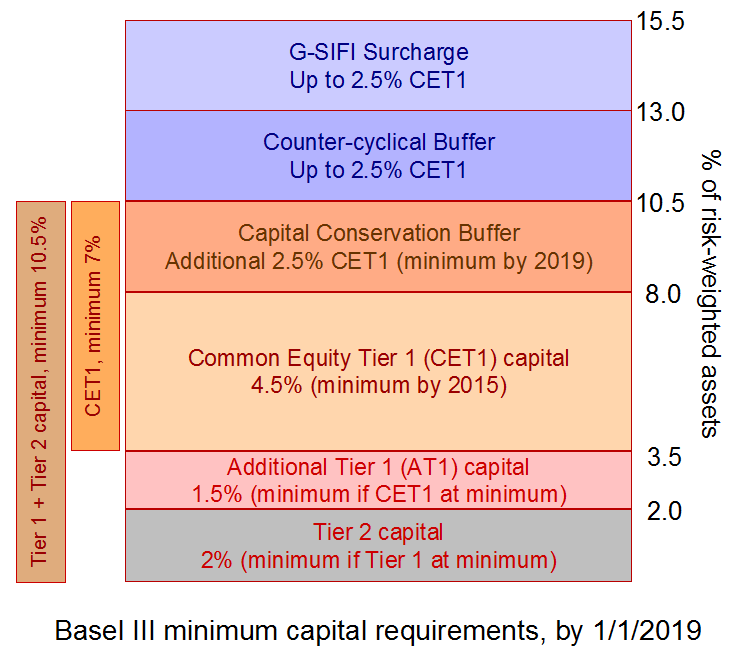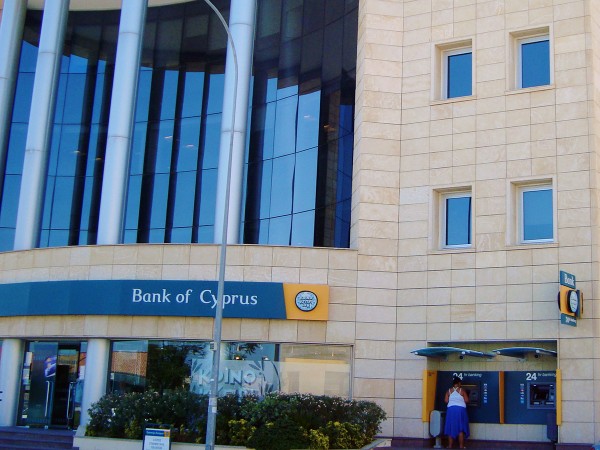 Following the banking crisis of 2007/8 a new set of international banking regulations was agreed in 2010 by the Basel Committee on Banking Supervision. The purpose was to strengthen banks’ capital base. Under ‘Basel III’, banks would be required, in stages, to meet specific minimum capital adequacy ratios: i.e. minimum ratios of capital to (risk-weighted) assets. The full regulations would come into force by 2019. These are shown in the chart below.
Following the banking crisis of 2007/8 a new set of international banking regulations was agreed in 2010 by the Basel Committee on Banking Supervision. The purpose was to strengthen banks’ capital base. Under ‘Basel III’, banks would be required, in stages, to meet specific minimum capital adequacy ratios: i.e. minimum ratios of capital to (risk-weighted) assets. The full regulations would come into force by 2019. These are shown in the chart below.
The new Financial Policy Committee of the Bank of England has judged that some UK banks have insufficient ‘common equity tier 1 capital’. This is defined as ordinary shares in the bank plus the bank’s reserves. According to the Bank of England:
… the immediate objective should be to achieve a common equity tier 1 capital ratio, based on Basel III definitions and, after the required adjustments, of at least 7% of risk-weighted assets by end 2013. Some banks, even after the adjustments described above, have capital ratios in excess of 7%; for those that do not, the aggregate capital shortfall at end 2012 was around £25 billion.
Thus the banking system in the UK is being required, by the end of 2013, to meet the 7% ratio. This could be done, either by increasing the amount of capital or by reducing the amount of assets. The Bank of England is keen for banks not to reduce assets, which would imply a reduction in lending. Similarly, it does not want banks to increase reserves at the expense of lending. Either action could push the economy back into recession. Rather the Bank of England wants banks to raise more capital. But that requires sufficient confidence by investors.
 And the end of this year is not the end of the process. After that, further increases in capital will be required, so that by 2019 banks are fully compliant with Basel III. All this will make it difficult for certain banks to raise enough capital from investors. As far as RBS and the Lloyds Banking Group are concerned, this will make the prospect of privatising them more difficult. But that is what the government eventually wants. It does not want the taxpayer to have to find the extra capital. Re-capitalising the banks, or at least some of them, may prove difficult.
And the end of this year is not the end of the process. After that, further increases in capital will be required, so that by 2019 banks are fully compliant with Basel III. All this will make it difficult for certain banks to raise enough capital from investors. As far as RBS and the Lloyds Banking Group are concerned, this will make the prospect of privatising them more difficult. But that is what the government eventually wants. It does not want the taxpayer to have to find the extra capital. Re-capitalising the banks, or at least some of them, may prove difficult.
The following articles look at the implications of the FPC judgement and whether strengthening the banks will strengthen or weaken the rest of the economy.
Articles
Financial policy committee identifies £25bn capital shortfall in UK banks The Guardian, Jill Treanor (27/3/13)
Banks Told To Raise Capital By Financial Policy Committee To Cushion Against A Crisis Huffington Post (27/3/13)
UK banks’ £25bn shortfall: positive for banks, negative for BoE credibility, Sid Verma (27/3/13)
Doubts over Bank of England’s £25bn confidence game The Telegraph, Harry Wilson (27/3/13)
Bank of England tells banks to raise £25bn BBC News (27/3/13)
Q&A: Basel rules on bank capital – who cares? Laurence Knight (13/9/10)
U.K. Banks Seen Avoiding Share Sales After BOE Capital Review Bloomberg Businessweek, Gavin Finch and Howard Mustoe (27/3/13)
Banks Cut Basel III Shortfall by $215 Billion in Mid-2012 Bloomberg (19/3/13)
Will strengthening banks weaken the economy? BBC News, Robert Peston (27/3/13)
Bank of England News Release
Financial Policy Committee statement from its policy meeting, 19 March 2013 Bank of England (27/3/13)
Questions
- Explain the individual parts of the chart.
- What do you understand by risk-weighted assets?
- Distinguish between capital adequacy ratios and liquidity ratios.
- What could the banks do to increase their capital adequacy ratios? Compare the desirability of each method.
- If all banks around the world were Basel III compliant, would this make another global banking crisis impossible?
 After a week of turmoil in Cyprus (see the News item Ochi, ochi, ochi) a deal has been struck between Cyprus, the EU and the IMF over a €10bn bailout for the island’s banking system. But while the deal may bring the immediate crisis to an end, the Cypriot economy could face years of austerity and depression. And there remain questions over whether the deal sends the wrong message to depositors in banks in other eurozone countries whose banking systems are under pressure.
After a week of turmoil in Cyprus (see the News item Ochi, ochi, ochi) a deal has been struck between Cyprus, the EU and the IMF over a €10bn bailout for the island’s banking system. But while the deal may bring the immediate crisis to an end, the Cypriot economy could face years of austerity and depression. And there remain questions over whether the deal sends the wrong message to depositors in banks in other eurozone countries whose banking systems are under pressure.
Unlike the original EU proposal, the deal will not impose a levy on deposits under €100,000, much to the relief of small and medium depositors. But individuals and businesses with deposits over €100,000 in the two main troubled banks (Laiki and the Bank of Cyprus) will face losses that could be as high as 40%. The precise size will become clear in the coming days.
The troubled second largest bank, Laiki (Popular) Bank, will be split into a ‘good’ and a ‘bad’ bank. The assets and liabilities of the good part will be taken over by the largest bank, the Bank of Cyprus. Thus people’s accounts under €100,000 will be moved from one to the other. The ‘bad’ part will include deposits over €100,000 and bonds. Holders of these could lose a substantial proportion of their value.
 Many businesses will be hard hit and may be forced to close. This could have serious adverse multiplier effects on the economy. These effects will be aggravated by the fiscal austerity measures which are also part of the deal. The measures are also likely to discourage further inward investment, again pushing the economy further into recession.
Many businesses will be hard hit and may be forced to close. This could have serious adverse multiplier effects on the economy. These effects will be aggravated by the fiscal austerity measures which are also part of the deal. The measures are also likely to discourage further inward investment, again pushing the economy further into recession.
And then there are the broader effects on the eurozone. The direct effect of a decline in the Cypriot economy would be tiny; the Cypriot economy accounts for a mere 0.2% of eurozone GDP. Also the effect on small savers in other eurozone countries is also likely to be limited, as people will probably be reassured that savings under €100,000 have remained protected, even in an economy as troubled as Cyprus.
But some commentators argue that the effect on large depositors in other troubled eurozone countries, such as Portugal, Spain, Greece and Italy, could be much more serious. Would people with large balances in these countries prefer to move their money to, say, Germany, or even out of the eurozone altogether? There is clearly disagreement over this last point as you will see from the articles below.
Webcasts and Podcasts
 Cyprus agrees bailout with eurozone ministers The Guardian (25/3/13)
Cyprus agrees bailout with eurozone ministers The Guardian (25/3/13)
 Cyprus bailout: Deal reached in Eurogroup talks BBC News (25/3/13)
Cyprus bailout: Deal reached in Eurogroup talks BBC News (25/3/13)
 ‘Disaster avoided’ as Cyprus agrees EU bailout deal Euronews (25/3/13)
‘Disaster avoided’ as Cyprus agrees EU bailout deal Euronews (25/3/13)
 Cyprus saved from bankruptcy Channel 4 News on YouTube, Faisal Islam (25/3/13)
Cyprus saved from bankruptcy Channel 4 News on YouTube, Faisal Islam (25/3/13)
 What are the implications of the Cyprus deal? BBC Radio 4 Today Programme, Stephanie Flanders (25/3/13)
What are the implications of the Cyprus deal? BBC Radio 4 Today Programme, Stephanie Flanders (25/3/13)
 Cyprus bailout deal: Russia riled but Germany relieved BBC News, Steve Rosenberg in Moscow and Stephen Evans in Berlin (25/3/13)
Cyprus bailout deal: Russia riled but Germany relieved BBC News, Steve Rosenberg in Moscow and Stephen Evans in Berlin (25/3/13)
 Cyprus bailout deal ‘durable’ says IMF chief BBC News, Christine Lagarde (25/3/13)
Cyprus bailout deal ‘durable’ says IMF chief BBC News, Christine Lagarde (25/3/13)
 Cyprus Bailout Deal Raises Questions: Lombardi Bloomberg, Domenico Lombardi (25/3/13)
Cyprus Bailout Deal Raises Questions: Lombardi Bloomberg, Domenico Lombardi (25/3/13)
 Minister Michalis Sarris: Cyprus paying ‘tremendous cost’ BBC Radio 4 Today Programme, Michalis Sarris (26/3/13)
Minister Michalis Sarris: Cyprus paying ‘tremendous cost’ BBC Radio 4 Today Programme, Michalis Sarris (26/3/13)
Articles
Last-minute Cyprus deal to close bank, force losses Reuters, Jan Strupczewski and Annika Breidthardt (25/3/13)
Cyprus strikes last-minute EU bailout deal The Guardian, Ian Traynor (25/3/13)
‘There is no future here in Cyprus’ The Telegraph, Nick Squires (25/3/13)
Back from the brink: EU ministers approve €10bn bailout deal at 11th-hour to save Cyprus Independent, Charlotte McDonald-Gibson and Majid Mohamed (25/3/13)
Cyprus bailout: Deal reached in Eurogroup talks BBC News (25/3/13)
Q&A: Cyprus deal BBC News (25/3/13)
The rescue of Cyprus won’t feel like one to its people BBC News, Robert Peston (25/3/13)
Lessons of Cyprus BBC News, Stephanie Flanders (25/3/13)
Cyprus bailout: Dijsselbloem remarks alarm markets BBC News (25/3/13)
Cyprus saved – but at what cost? The Guardian, Helena Smith (25/3/13)
Cyprus bail-out: savers will be raided to save euro in future crisis, says eurozone chief The Telegraph, Bruno Waterfield (25/3/13)
Cyprus’s banks have been tamed – are Malta and Luxembourg next? The Guardian, Ian Traynor (25/3/13)
Lehman lessons weigh on Cyprus talks but 1920s slump must not be ignored The Guardian, Larry Elliott (24/3/13)
Questions
- Explain what is meant by ‘moral hazard’. What moral hazards are implicit in the deal that has been struck with Cyprus?
- How does the size of the banking system in Cyprus as a proportion of GDP differ from that in other troubled eurozone countries? How does this affect the ‘contagion’ argument?
- Does the experience of Iceland and its troubled banks suggest that the Cypriot problem has nothing to do with its being in the eurozone?
- What options are open to the Cypriot government to stimulate the economy and prevent a severe recession? How realistic are these options (if any)?
- What are the likely implications of the deal for the economic relationships (as opposed to the political ones) between Cyprus and Russia and between the eurozone and Russia?
- Are there any similarities in the relationships between the weak and strong eurozone countries today and those between Germany and other countries in the 1920s and 30s?
 Banks in Cyprus are in crisis. They have many bad debts e.g. to Greece and as mortgages in a falling property market. Private-sector debts have become unsustainable for the banks. The problem is compounded by negative economic growth and large government deficits (see chart). But, as with Icelandic banks back in 2008, this means a crisis for the whole country.
Banks in Cyprus are in crisis. They have many bad debts e.g. to Greece and as mortgages in a falling property market. Private-sector debts have become unsustainable for the banks. The problem is compounded by negative economic growth and large government deficits (see chart). But, as with Icelandic banks back in 2008, this means a crisis for the whole country.
The reason is that the banking sector in Cyprus, as in Iceland and Ireland too, is large relative to the whole economy – over 8 times annual GDP (second only to Ireland in the EU). Loans to Greece alone are as much as 160% of Cyprus’ GDP and Cypriot banks were badly hit by the terms of the Greek bailout, which required creditors to take a 53% reduction (or ‘haircut’) in the value of their loans to Greece. With such a large banking sector, it is impossible for the Cypriot government alone to rescue the banks.
Cyprus thus turned to the EU for a bailout: back in June 2012. This makes Cyprus the fifth country to seek a bailout (after Greece, Ireland, Portugal and Spain). A bailout of €10 billion has just been agreed by the EU and IMF. The bailout comes with the ‘usual’ conditions of strong austerity measures of tax rises and cuts in government expenditure. But what makes this bailout different from those given to the other countries was a proposed levy on savers.
 The proposal was that people with up €99,999 in their bank accounts (of any type) would face a one-off tax of 6.75%. The rate for those with €100,000 or more would be 9.9%, including on the first €99,999. This would raise around €5.8 billion of the €10 billion.
The proposal was that people with up €99,999 in their bank accounts (of any type) would face a one-off tax of 6.75%. The rate for those with €100,000 or more would be 9.9%, including on the first €99,999. This would raise around €5.8 billion of the €10 billion.
Not surprisingly, there was a public outcry in Cyprus. People had thought that their deposits were protected (at least up to €100,000). There was a run on cash machines, which, as a result were set to deliver just small amounts of cash to cope with the excessive demand. There was huge pressure on the Cypriot government not to introduce the measure.
But the ramifications of the proposed levy go well beyond the question of justice to savers. Questions are being raised about its incentive/disincentive effects. If people in other countries in future financial difficulties felt that they might face similar levies, how would they behave? Also, there is no haircut being proposed for holders of banks’ bonds. As Robert Peston states in his first article below:
The Cypriot deal sets back the cause of the new global rules for bringing order to banking systems when crisis hits. Apart from anything else, in other eurozone countries where banks are weak, it licenses runs on those banks, as and when a bailout looms.
But getting incentives right is not easy. As the Buttonwood column in The Economist points out:
The problem is tied up with the issue of moral hazard. This can be applied to both creditors and debtors; the former should be punished for reckless lending and the latter for living beyond their means. The collapse of Lehman Brothers is seen as an example of the faulty reasoning behind moral hazard; by letting the bank go bust, the crisis was spread throughout the financial system. But rescuing every creditor (or intervening to bail out the markets every time they falter) is the reason we are in this mess.
One alternative considered by the Cyprus parliament was to exempt people with less than €20,000 in their accounts from the levy. But this was rejected as being insufficient protection for savers. Another is to exempt people with less than €100,000, or to charge people with between €20,000 and €100,000 at a lower rate or rates.
But charging less, or nothing, on deposits of less than €100,000 would make it harder to to raise the €5.8 billion required by the EU. Without alternative measures it would mean charging a rate higher than 9.9% on larger deposits. The Cypriot government is afraid that this would discourage inward investment. Russia, in particular, has invested heavily in the Cyprus economy and Russia is campaigning vigorously to limit the size of the levy on large deposits. But there is little sympathy for Russian depositors, much of whose deposits are claimed to be ‘laundered money’. The Cypriot government has been seeking financial support from the Russian government.
An alternative proposal being considered is to issue government bonds in an “investment solidarity fund” and to transfer pension funds from semi-public companies to the state. Also Russia may be willing to invest more money in Cyprus’ offshore oil and gas fields.
Agreement
A deal was struck between Cyprus and the EU/IMF early in the morning of 25 March, just hours before the deadline. For details, see the News Item Cyprus: one crisis ends; another begins.
Webcasts and podcasts
 Eurozone ministers agree 10bn euro Cyprus bailout Channel 4 News (16/3/13)
Eurozone ministers agree 10bn euro Cyprus bailout Channel 4 News (16/3/13)
 Bailout is ‘blackmail’ claims Cyprus president Euronews (17/3/13)
Bailout is ‘blackmail’ claims Cyprus president Euronews (17/3/13)
 Cyprus’s president tries to calm fears over EU bailout The Guardian (18/3/13)
Cyprus’s president tries to calm fears over EU bailout The Guardian (18/3/13)
 Cypriot bank customers reactions to savings levy BBC News (17/3/13)
Cypriot bank customers reactions to savings levy BBC News (17/3/13)
 Cyprus bailout: Parliament postpones debate amid anger BBC News (17/3/13)
Cyprus bailout: Parliament postpones debate amid anger BBC News (17/3/13)
 Cyprus parliament delays debate on EU bailout Al Jazeera (17/3/13)
Cyprus parliament delays debate on EU bailout Al Jazeera (17/3/13)
 Cyprus told it can amend bailout, as key vote postponed BBC News, Gavin Hewitt (18/3/13)
Cyprus told it can amend bailout, as key vote postponed BBC News, Gavin Hewitt (18/3/13)
 Robert Peston: Cyprus bailout an ‘astonishing mess’ BBC News, Robert Peston (18/3/13)
Robert Peston: Cyprus bailout an ‘astonishing mess’ BBC News, Robert Peston (18/3/13)
 Cyprus bailout is ‘completely unfair’ BBC Radio 4 Today Programme, Michael Fuchs and Bernadette Segol (18/3/13)
Cyprus bailout is ‘completely unfair’ BBC Radio 4 Today Programme, Michael Fuchs and Bernadette Segol (18/3/13)
 Lenders ‘doing everything you should not do’ on Cyprus BBC Radio 4 Today Programme, Alistair Darling (19/3/12)
Lenders ‘doing everything you should not do’ on Cyprus BBC Radio 4 Today Programme, Alistair Darling (19/3/12)
 Cyprus warned over bailout rejection BBC News (20/3/13)
Cyprus warned over bailout rejection BBC News (20/3/13)
Articles
Cyprus becomes fifth eurozone bailout The News International (Pakistan) (17/3/13)
Cyprus bailout deal sparks run on ATMs Irish Independent (17/3/13)
EU leaders gamble in Cyprus bank bailout BBC News, Gavin Hewitt (17/3/13)
Cyprus told it can amend bailout, as key vote postponed BBC News (18/3/13)
Q&A: Cyprus bailout BBC News (19/3/13)
Cyprus’ President Defends Bailout Deal The Motley Fool (16/3/13)
Sad Cyprus The Economist, Buttonwood’s Notebook (12/3/13)
The Cypriot bail-out: A fifth bitter lemon The Economist (30/6/12)
Analysis: Cyprus bank levy risks dangerous euro zone precedent Reuters, Mike Peacock (17/3/13)
The Cyprus precedent Reuters, Felix Salmon (17/3/13)
The Cyprus Bank Bailout Could Be A Disastrous Precedent: They’re Reneging On Government Deposit Insurance Forbes, Tim Worstall (16/3/13)
Cyprus rescue breaks all the rules BBC News, Robert Peston (18/3/13)
Cyprus and the eurozone’s survival BBC News, Robert Peston (20/3/13)
Eurogroup defends Cyprus bail-out The Telegraph (17/3/13)
Cyprus eurozone bailout prompts anger as savers hand over possible 10% levy The Guardian (16/3/13)
Cyprus’s wealth tax makes perfect sense – its rich won’t escape unscathed The Guardian, Phillip Inman (18/3/13)
The tragedy of Cyprus The Real Economy blog, Edmund Conway (16/3/13)
Damage limitation in Cyprus BBC News, Stephanie Flanders (19/3/13)
The fatal flaw in the eurozone’s not-so-cunning plan for Cyprus The Guardian, Larry Elliott (19/3/13)
Cyprus plans special fund in race to get EU-IMF bailout BBC News, (21/3/13)
Cyprus says ‘significant progress’ in debt crisis talks BBC News (23/3/13)
Background information
The Banking System in Cyprus: Time to Rethink the Business Model? Cyprus Economic Policy Review, Vol. 5, No. 2, pp. 123–130, Constantinos Stephanou (2011)
European sovereign-debt crisis Wikipedia
Questions
- What is the justification given by the Cypriot government and the EU for imposing a levy on bank deposits?
- What alternative measures could have been demanded by the EU? Why weren’t they?
- What is the significance of Russian deposits in Cypriot banks?
- Compare the benefits of the proposed levy rates with the alternative of imposing levies only on deposits over €100,000, but at higher rates (perhaps tiered).
- Explain the moral hazard issues in bailing out the Cypriot banks.
- How serious is the problem that imposing a tax on deposits in Cypriot banks might have adverse affects on the behaviour of depositors in other countries’ banks?
- How might Cypriots behave in future in regards to depositing money in banks? What impact could this have on the economy of Cyprus?
- Explain “the unholy trinity of options facing indebted nations (inflate, stagnate, default)”. Compare the effectiveness of each.
 Inflation is measured as the percentage increase in the Consumer Prices Index (CPI) over the previous 12 months. The index is constructed from a basket of goods that is supposed to represent the buying habits of an average UK household. This basket is updated each year as tastes change and as technology moves forward. The basket contains approximately 700 items, with 180,000 individual prices collected each month.
Inflation is measured as the percentage increase in the Consumer Prices Index (CPI) over the previous 12 months. The index is constructed from a basket of goods that is supposed to represent the buying habits of an average UK household. This basket is updated each year as tastes change and as technology moves forward. The basket contains approximately 700 items, with 180,000 individual prices collected each month.
As certain goods become more popular and trends change, the ONS have the responsibility of identifying these changes and updating the basket of goods. The CPI then looks at how the weighted average price of this basket of goods changes from one month to the next. As the CPI gives us the main measure of UK inflation, it is essential that the basket of goods used does represent current consumer demands. If the basket of goods used 20 years ago was still in place, we wouldn’t see thing like mobile phones and ipads being included. This is one sector that has seen significant growth in recent years and the basket of goods has been adapted in response. A new addition to the measure is e-books, which have seen a significant growth in popularity.
 However, just as new products have been added to the CPI measure, other goods have been removed. In the most recent update, we’ve seen the removal of champagne and Freeview boxes from the basket of goods. With rapid changes in technological products, such as the ipad, kindle and e-books, products that were new additions only a few years ago are now old news, being replaced by the latest gadgets. Other changes to the basket of goods are less about reflecting consumer trends and more about making certain categories more representative, such as fruits and hot drinks.
However, just as new products have been added to the CPI measure, other goods have been removed. In the most recent update, we’ve seen the removal of champagne and Freeview boxes from the basket of goods. With rapid changes in technological products, such as the ipad, kindle and e-books, products that were new additions only a few years ago are now old news, being replaced by the latest gadgets. Other changes to the basket of goods are less about reflecting consumer trends and more about making certain categories more representative, such as fruits and hot drinks.
So, can the changes in the basket of goods tell us anything about the impact of the recession on buying habits? One notable exclusion from the basket of goods is champagne sold in restaurants and bars. In an economic downturn, you’d expect luxury products to see a decline in consumption and the trend in champagne consumption certainly seems to support the theory. The trends suggest that consumers have instead switched to cheaper alternatives, with things like white rum bought from shops increasing.
Many people may look at the basket of goods and think that it doesn’t reflect what you buy in your average shop. But, the purpose of the CPI is to try to reflect the average consumer and the different items in the basket are given different weightings to give some indication of the amount spent on each good. The articles below look at the changes in the CPI basket of goods and what, if anything, we can take from it.
Inflation basket: E-books added by ONS BBC News (12/3/13)
Inflation basket – what does it say about you? Channel 4 News (12/3/13)
The fizz has fallen flat – champagne cut from inflation basket Independent, Martin Hickman (13/3/13)
E-books added to inflation basket, as champagne dropped The Telegraph, Philip Aldrick (13/3/13)
UK inflation basket: e-books in, champagne out The Guardian, Marking King (13/3/13)
Champagne tipped out of inflation basket Financial Times, Hannah Kuchler (13/3/13)
Champagne out, ebooks in as inflation basket updated Reuters (13/3/13)
Questions
- What is inflation and why is it such an important variable?
- How is the CPI calculated? Is it different from the RPI?
- What impact has technological change had on the basket of goods used to calculate the CPI?
- Can you identify any other economic or business trends from the products that are in and out of the CPI basket of goods?
- Given the importance of technology and the speed of change, do you think the review of the basket of goods should become more or less frequent?
- Has the economic downturn had any effect on the basket of goods used to calculate the CPI?
 The UK economy is suffering from a lack of aggregate demand. Low spending in real terms is preventing the economy from growing. A simple solution would seem to be to stimulate aggregate demand through fiscal policy, backed up by even looser monetary policy. But this is easier said than done and could result in undesirable consequences in the medium term.
The UK economy is suffering from a lack of aggregate demand. Low spending in real terms is preventing the economy from growing. A simple solution would seem to be to stimulate aggregate demand through fiscal policy, backed up by even looser monetary policy. But this is easier said than done and could result in undesirable consequences in the medium term.
If increased borrowing were to be used to fund increased government expenditure and/or cuts in taxes, would any resulting growth be sufficient in the medium term to reduce the public-sector deficit below the initial level through automatic fiscal stabilisers? And would the growth be sustainable? The answer to this second question depends on what happens to the supply side of the economy. Would there be an increase in aggregate supply to match the increase in aggregate demand?
 This second question has led many economists to argue that we need to see a rebalancing of the economy. What is needed is an increase in investment and exports, rather than an increase in just consumer expenditure funded by private borrowing and government current expenditure funded by public borrowing.
This second question has led many economists to argue that we need to see a rebalancing of the economy. What is needed is an increase in investment and exports, rather than an increase in just consumer expenditure funded by private borrowing and government current expenditure funded by public borrowing.
But how will exports and investment be stimulated? As far as exports are concerned, it was hoped that the depreciation of the pound since 2008 would give UK exporters a competitive advantage. Also domestic producers would gain a competitive advantage in the UK from imports becoming more expensive. But the current account deficit has actually deteriorated. According to the EU’s AMECO database, in 2008 the current account deficit was 1% of GDP; in 2012 it was 3.7%. It would seem that UK producers are not taking sufficient advantage of the pound’s depreciation, whether for exports or import substitutes.
 As far as investment is concerned, there are two major problems. The first is the ability to invest. This depends on financing and things such as available land and planning regulations. The second is the confidence to invest. With not little or no growth in consumer demand, there is little opportunity for the accelerator to work. And with forecasts of sluggish growth and austerity measures continuing for some years, there is little confidence in a resurgence in consumer demand in the future. (Click here for a PowerPoint of the above chart. Note that the 2013 plots are based on AMECO forecasts.)
As far as investment is concerned, there are two major problems. The first is the ability to invest. This depends on financing and things such as available land and planning regulations. The second is the confidence to invest. With not little or no growth in consumer demand, there is little opportunity for the accelerator to work. And with forecasts of sluggish growth and austerity measures continuing for some years, there is little confidence in a resurgence in consumer demand in the future. (Click here for a PowerPoint of the above chart. Note that the 2013 plots are based on AMECO forecasts.)
So hope of a rebalancing is faint at the current time. Hence the arguments for an increase in government capital expenditure that we looked at in the last blog post (The political dynamite of calm economic reflection). The problem and the options for government are considered in the following articles.
Articles
Budget 2013: Chancellor’s rebalancing act BBC News, Stephanie Flanders (11/3/13)
Why George Osborne is failing to rebalance the economy The Guardian, Larry Elliott (17/3/13)
Economy fails to ‘rebalance’ Financial Times, Sarah O’Connor (27/2/13)
Analysis – Long haul ahead for Britain’s struggling economy Reuters, William Schomberg (3/3/13)
Can banks be forced to lend more? BBC News, Robert Peston (12/3/13)
Budget 2013: What the commentators are saying BBC News (13/3/13)
Data
UK Trade, January 2013 (ONS) (12/3/13)
Business investment, Q4 2012 ONS (27/2/13)
Questions
- Draw a diagram to illustrate the effects of a successful policy to increase both aggregate demand and aggregate supply. What will determine the effect on the output gap?
- For what reasons has the UK’s current account deteriorated over the past few years while those of the USA and the eurozone have not?
- Using ONS data, find out what has happened to the UK’s balance of trade in (a) goods and (b) services over the past few years and explain your findings.
- Why are firms reluctant to invest at the moment? What policy measures could the government adopt to increase investment?
- With interest rates so low, why don’t consumers borrow and spend more, thereby aiding the recovery?
 Following the banking crisis of 2007/8 a new set of international banking regulations was agreed in 2010 by the Basel Committee on Banking Supervision. The purpose was to strengthen banks’ capital base. Under ‘Basel III’, banks would be required, in stages, to meet specific minimum capital adequacy ratios: i.e. minimum ratios of capital to (risk-weighted) assets. The full regulations would come into force by 2019. These are shown in the chart below.
Following the banking crisis of 2007/8 a new set of international banking regulations was agreed in 2010 by the Basel Committee on Banking Supervision. The purpose was to strengthen banks’ capital base. Under ‘Basel III’, banks would be required, in stages, to meet specific minimum capital adequacy ratios: i.e. minimum ratios of capital to (risk-weighted) assets. The full regulations would come into force by 2019. These are shown in the chart below. And the end of this year is not the end of the process. After that, further increases in capital will be required, so that by 2019 banks are fully compliant with Basel III. All this will make it difficult for certain banks to raise enough capital from investors. As far as RBS and the Lloyds Banking Group are concerned, this will make the prospect of privatising them more difficult. But that is what the government eventually wants. It does not want the taxpayer to have to find the extra capital. Re-capitalising the banks, or at least some of them, may prove difficult.
And the end of this year is not the end of the process. After that, further increases in capital will be required, so that by 2019 banks are fully compliant with Basel III. All this will make it difficult for certain banks to raise enough capital from investors. As far as RBS and the Lloyds Banking Group are concerned, this will make the prospect of privatising them more difficult. But that is what the government eventually wants. It does not want the taxpayer to have to find the extra capital. Re-capitalising the banks, or at least some of them, may prove difficult.








